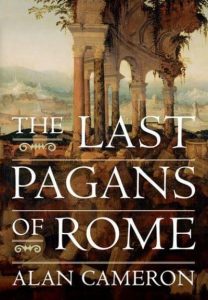In a little section called “Spiritual Overinsurance,” Jonathan Kirsch (God Against the Gods) writes:
“Thus, for example, a pagan might be a devotee of the stately old gods of Rome and Greece whom Homer calls ‘the Olympians’ — Apollo and Zeus, Aphrodite and Athena — and at the very same time, a worshipper of the Syrian goddess known as the Great Mother, the Persian god called Mithra or the newfangled cult that conjoined the Egyptian goddess Isis and a freshly minted god called Serapis, a conflation of two older Eygptian deities. One famous pagan called Praetextatus, a contemporary of both Constantine and Julian, is described on his epitaph as a proud collector of pagan priesthoods and initiations of all kinds: ‘high priest of Vesta, high priest of the sun, a priest of Hercules, an initiate of the mysteries of Dionysos and Eleusis, priest and temple guardian in the mystery of Cybele, and Father in the mystery of Mithras.’ It says as much about paganism, as about Praetextatus that he used to joke with the pople that ‘he might be tempted to become a Christian by the prospect of being Bishop of Rome.’
“So welcoming was polytheism that even the holiest figures of monotheism were recruited into Greco-Roman paganism. One emperor . . . adorned his private chapel with ‘statues of Abraham, of Orpheus, of Apollonius, and of Christ,’ writes Edward Gibbon of Alexander Severus (208-235) . . . .
“Even Yahweh, regarded by strict monotheists who wrote the bible as the one and only god, was made over into the deity called Iao and given a place among the many gods and goddesses of paganism. . . . [T]hey wanted to make sure that they did not forfeit the blessing of the right god by making sure to worship all gods — a practice that historian Robin Lane Fox describes as “spiritual over-insurance. . . .
“’Whilst all nations and kingdoms honor their respective god, the Romans respect the gods of all the others, just as their power and authority have reached the compass of the whole world,’ boasts the pagan orator Caecillus. ‘They search out everywhere these foreign gods, and adopt them for their own; nay, they even erected altars to unknown gods.”
Normally, I enjoy Jonathan Kirsch, but God Against the Gods is really just a popular history of the transition from paganism to Christianity in the Roman empire. I read it in an evening, and didn’t see anything that I didn’t already know, or that any reasonably well-informed lay person wouldn’t already know. I’d recommend it primarily to people who already know that the triumph of Christianity was largely the result of politics, but who are bit fuzzy on the details.
The passage quoted above caught my eye for a very personal reason. I’m becoming increasingly annoyed by pagans and neopagans both who talk about “working with more than one pantheon.” I didn’t mind at first, but after a year of hearing it everywhere, it’s like a kind of water torture.
Who thought up this silliness, anyway? It sounds like Llewellyn Press nonsense to me. First, I don’t like the implicit idea that being a pagan involves working with a pantheon. It sounds like something from wicca and magic circles. I don’t work with my gods; I fulfill my duty by according them appropriate honor. Secondly, I’m not particularly fond of the implicit assumption that the gods can be neatly divided into discrete cultural packages. I guess some people suppose that gods are a consumer package like any other commodity — you do a bit of comparison shopping, then choose the style you want (but be careful that they go with the 9-piece living room suite from Sears, and make sure you can afford the payments).
The older I get, the more I go back to the core set of beliefs I already had when I was 14, and the more I’m prepared to ignore all the fluff I’ve learned to tolerate since then. I think of myself as a polytheist. I have my own set of preferred personal and family gods, who happen to be Norse. But I don’t deny the existence of the others. In fact, I think a good case can be made that the Christian god and the Greek and Roman gods are the appropriate civic and cultural gods of America. If I occasionally offer a pinch of cornmeal to Tonantzin as Queen of the Americas, or a pinch of incense to Hermes as a patron of lawyers (and thieves), I don’t see that I’ve given offense to my family gods, and I certainly don’t think of myself as “working with more than one pantheon.”
In fine, it seems to me that all the hand-wringing on this subject is really only possible among people who aren’t polytheists in the traditional sense of the word, people who have some kind of new-agey “all the gods are one” philosophy. If you accept, as I do, the proposition that each of the gods is a distinct being, it’s only a short step to “spiritual over-insurance.”
